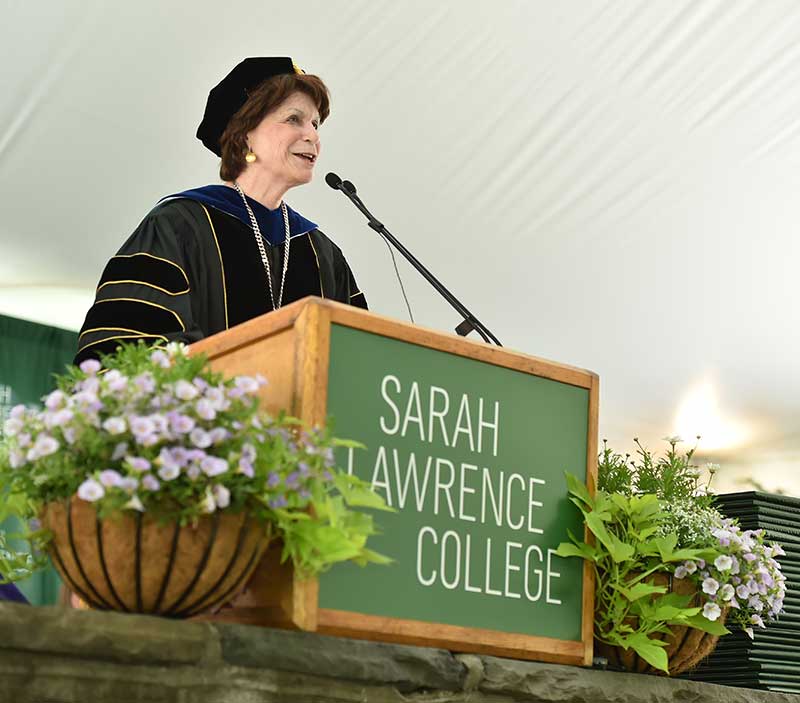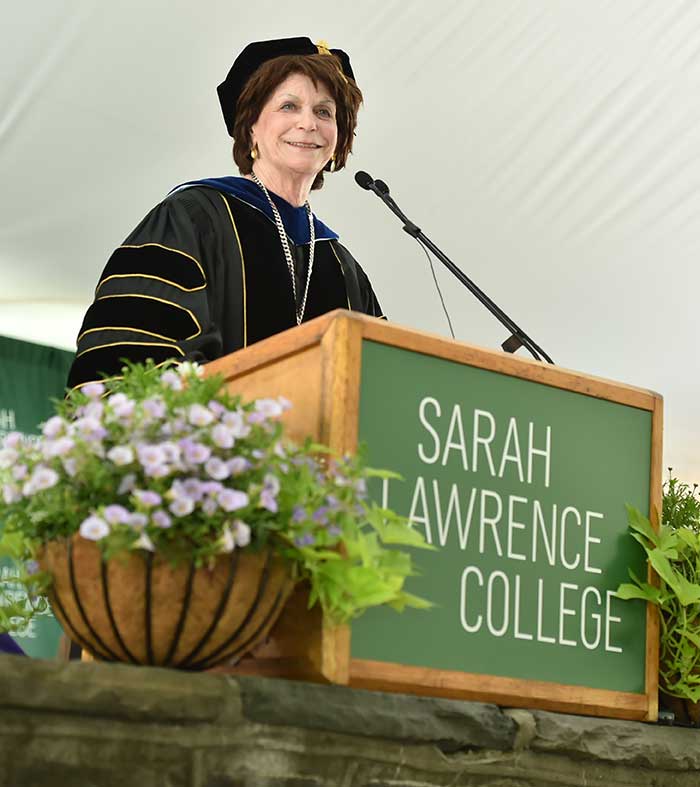On behalf of the Trustees, faculty, and staff of Sarah Lawrence College, I am delighted to welcome you to the Commencement of the class of 2017. To the graduating class, let me say that we all have taken great pleasure in witnessing in you the “transformative” effect that Sarah Lawrence alumni identify as the legacy of their educations.
As we celebrate our graduates today, we also honor those who made it possible for them to be here—their families, whose love and commitment supported them, including those who are no longer here to mark these milestones. I particularly want to acknowledge the parents in the audience, whose support often entails real sacrifice. Members of the Class of 2017, would you please stand and recognize the family members and friends who have made this moment possible?
The response our students give the faculty as they process at Commencement is an audible manifestation of the great affection and gratitude they feel toward their teachers every day of the year. This devotion to the faculty has been consistent over generations of Sarah Lawrence students and is probably the most common thread that ties Sarah Lawrence alumni together. One measure of the faculty’s impact was brought home to me a couple of years ago by a graduate of the class of 1969, who told me she could still recite both the names of her teachers and the titles of her conference papers after almost 50 years. I trust that some of you in the class of 2017 will be able to do the same 50 years from now.
 This graduation marks my tenth and final year of presiding over the commencement ceremonies at Sarah Lawrence. Beginning in 2007, I have had the pleasure of gazing out over a sea of beaming student faces and their proud families—and the honor of conferring degrees on behalf of the Trustees and faculty. On one hand, to serve for 10 years as the 10th president of a College where I can say, “I’m Karen Lawrence, president of Sarah Lawrence,” has felt a little like karma. On the other hand, my timing might have been better. I arrived at Sarah Lawrence in July of 2007, just before the global financial crisis. Of the situation on college campuses at that time, my colleague Tom Blum has said: “From 2007 to 2017, we lived through, in slow-motion, higher education’s equivalent of [a] 100-year storm, spread over 10 years,” an event that brought a level of economic turbulence that shattered assumptions, agendas, and endowments. Yet as an institution, we have more than weathered that storm by collectively relying on what we hope a Sarah Lawrence education develops in each student: resilience, creativity, and grit. As the faculty, staff, administration, and trustees addressed this financial crisis and its aftermath, the College kept its core educational values. We are stronger and more sustainable today, with more students applying, a more diverse student body enrolling and graduating, and an enhanced sense of community—both on campus and between the College and our neighbors. And that enhanced sense of community extends beyond our local borders: In the midst of a nasty and brutish national climate, Sarah Lawrence College has tried to be both a welcoming and inclusive harbor and a launching pad for graduates fierce enough to take on the challenges of this troubled and troubling world.
This graduation marks my tenth and final year of presiding over the commencement ceremonies at Sarah Lawrence. Beginning in 2007, I have had the pleasure of gazing out over a sea of beaming student faces and their proud families—and the honor of conferring degrees on behalf of the Trustees and faculty. On one hand, to serve for 10 years as the 10th president of a College where I can say, “I’m Karen Lawrence, president of Sarah Lawrence,” has felt a little like karma. On the other hand, my timing might have been better. I arrived at Sarah Lawrence in July of 2007, just before the global financial crisis. Of the situation on college campuses at that time, my colleague Tom Blum has said: “From 2007 to 2017, we lived through, in slow-motion, higher education’s equivalent of [a] 100-year storm, spread over 10 years,” an event that brought a level of economic turbulence that shattered assumptions, agendas, and endowments. Yet as an institution, we have more than weathered that storm by collectively relying on what we hope a Sarah Lawrence education develops in each student: resilience, creativity, and grit. As the faculty, staff, administration, and trustees addressed this financial crisis and its aftermath, the College kept its core educational values. We are stronger and more sustainable today, with more students applying, a more diverse student body enrolling and graduating, and an enhanced sense of community—both on campus and between the College and our neighbors. And that enhanced sense of community extends beyond our local borders: In the midst of a nasty and brutish national climate, Sarah Lawrence College has tried to be both a welcoming and inclusive harbor and a launching pad for graduates fierce enough to take on the challenges of this troubled and troubling world.
But no matter which year one enters the unique culture of Sarah Lawrence, a new student or a new president must learn how the educational philosophy of the College is actually lived on the pulses of everyday life. There is no substitute for being here and doing it. Bill Shullenberger recently reminded me that my own initiation into our pedagogy took place when he invited me to discuss Joyce’s Ulysses in his class, “Epic Vision and Tradition.” Armed with what Bill described as “my dog-eared and taped-together working copy of . . . Ulysses,” I taught his class, which gave me, in Bill’s words, my “first close-up interaction with our students at their most vital, curious, original, skeptical, and critical.” Early in my tenure at Sarah Lawrence, I also had the privilege of teaching my own seminar, called “Who’s Afraid of James Joyce,” and although I have always enjoyed teaching, working with Sarah Lawrence students on their conference papers helped me to begin to appreciate the commitment and passion on both sides of the teacher-student relationship here.
I also began to see how conference work helps us live up to our reputation, as students develop their individual voice by conducting work that is meaningful to them. In my decade as president, I have been impressed with the way students are encouraged to read deeply and to question, and through this individualized and rigorous quest, to resist what the French writer Gustave Flaubert called “received ideas,” a kind of group-think expressed in language well-worn in predictable grooves. To buck cultural or linguistic clichés has never been an easy proposition. Flaubert was a master of revealing how the pressure of conformity is exerted on human beings struggling to carve out their own signature, something—an idea, a mode of being—that they can call their own. The challenge is not necessarily to say something new, but to ‘unsay’ what has been said before in a language worn out by repetition and cliché. Flaubert’s novels demonstrate how people strive to use the tools at hand to transcend the ordinary, like Emma Bovary, drowning in small provincial French life, reading romantic novels and trying desperately, tragically, to turn her life into art. He captures this poignant struggle in a haunting metaphor:
“Human speech is like a cracked kettle on which we tap crude rhythms for bears to dance to, while we long to make music that will melt the stars.”
For John Dewey, the American pragmatist philosopher whose ideas were influential in the founding of Sarah Lawrence College, the realm of art is an arena that fosters “meanings that transcend...habit.” Our commencement speaker, J.J. Abrams, is a great example of a Sarah Lawrence education, someone who has used the tools, technologies, and genres at hand to bend and even break the rules, in serial acts of creating something new and fresh. My friend, Leslie Pintchik, a jazz composer and musician, calls it “playing music instead of playing notes.”
 With all the benefits of this rigorous education, you, the members of the class of 2017, in less than two hours, will officially graduate from Sarah Lawrence College. Your undergraduate experience will be over. Like the ending of a good novel, the ceremony of graduation brings a sense of completion and closure, a bounded narrative arc with a beginning and an end. The sense of an ending that accompanies the graduation ceremony, in particular, brings with it a mix of emotions—relief (maybe for some more than others), pride, nostalgia, and some anxiety. Yet, I want to suggest that in life, as in novels, beginnings and endings are rather arbitrary lines of demarcation.
With all the benefits of this rigorous education, you, the members of the class of 2017, in less than two hours, will officially graduate from Sarah Lawrence College. Your undergraduate experience will be over. Like the ending of a good novel, the ceremony of graduation brings a sense of completion and closure, a bounded narrative arc with a beginning and an end. The sense of an ending that accompanies the graduation ceremony, in particular, brings with it a mix of emotions—relief (maybe for some more than others), pride, nostalgia, and some anxiety. Yet, I want to suggest that in life, as in novels, beginnings and endings are rather arbitrary lines of demarcation.
Let me explain, and not surprisingly, I am going to use literature to do so. In a preface to his novel, Roderick Hudson, Henry James discusses how a writer decides where to end his or her novel. James writes:
“Really, universally, relations stop nowhere and the exquisite problem of the artist is eternally but to draw, by a geometry of his own, the circle within which they shall happily appear to do so.”
What James is saying here is that the good artist cuts off the narrative thread arbitrarily, only making it seem ‘natural’ that the story draws to a close through this particular “geometry.” James was a master critic as well as a master novelist; in his prefaces he discloses what he disguises in his fiction: that the frame of the narrative—its beginning and ending—is part of a continuum, a thread arbitrarily cut-off on both ends.
As you know, the word “commencement” is often used to refer to a graduation, suggesting, rightly, that you are really going forth to a new beginning. But, along with Henry James, I want to emphasize something different. The sense of an ending that accompanies the ceremony of graduation belies the web of connections that extends beyond the ending, those tendrils and shoots that have been budding and will continue to grow. The seminars, labs, 3 a.m. conversations with friends, the discussions and products of discussion with your dons and teachers—these “relations stop nowhere.” As the author of your own narrative, drawing the “exquisite geometry” of your Sarah Lawrence experience, please keep in mind this often-unpredictable continuity, the vibrant afterlife of your Sarah Lawrence education. And I know you will hear reverberations in surprising places. Recently I heard a story about two apparent strangers who met on a guided tour in St. Petersburg. In listening to the guide speak about Dostoevsky, each mentioned that she had had the best Russian literature professor in College many years ago. At the end of the tour, they discovered, not surprisingly, that they were both referring to the same Sarah Lawrence professor, Marc Slonim, a renowned Russian literature scholar and critic!
Class of 2017, when you return for your reunions—as I know many will do—I am sure you will also have tales of such karmic connections. I wish you great joy in the relations that you have set in motion. And, indulging in a bit of projection—and nostalgia-- as we both “graduate” from Sarah Lawrence, I look forward to the way our narrative threads will continue to intertwine.